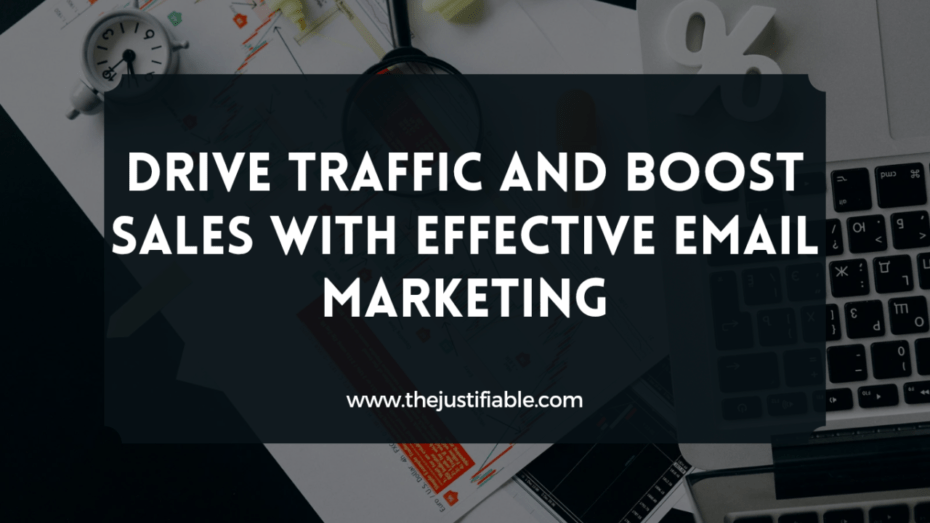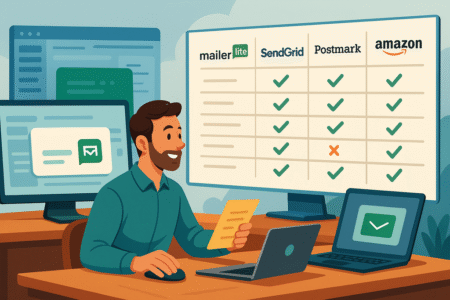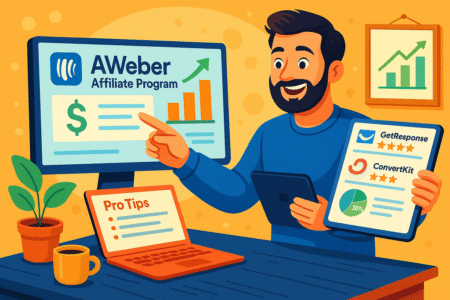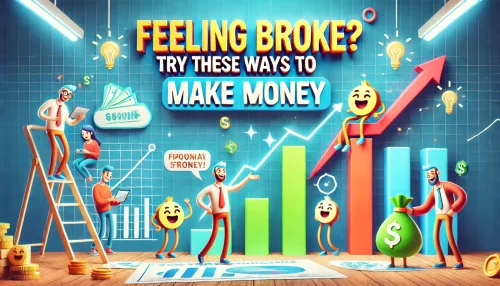Table of Contents
Drive Traffic and Boost Sales with Effective Email Marketing!
In a digital landscape where attention is gold, every business is in an ongoing quest to engage potential customers and direct them to their services. With numerous strategies available, one stands out due to its effectiveness and direct approach: Email Marketing.
When implemented effectively, email marketing has the potential not only to drive traffic but also to boost sales remarkably.
Understanding the Power of Email Marketing
Before delving into the strategies and techniques, it’s crucial to first understand what email marketing entails and the power it holds in today’s business world.
What is Email Marketing and Why is it Important?
Email marketing is a digital strategy that involves sending emails to prospects and customers. It’s a direct form of marketing that allows businesses to reach their audience in an organized, personalized, and targeted manner. With an average return on investment (ROI) of $42 for every $1 spent, it’s no wonder email marketing is at the top of every marketer’s priority list.
The importance of email marketing stems from its capability to establish direct contact with customers. It’s personal, customizable, and highly effective at driving traffic to your website.
It bypasses the need to wait for users to stumble upon your content amongst the ocean of information on the internet. With an effective email marketing strategy, you can land directly in their inbox, drive traffic to your site, and ultimately, enhance your sales.
Key Benefits of Email Marketing
Email marketing provides numerous benefits that can help businesses boost their traffic and increase their sales. Here are the most prominent advantages:
- Improved Reach: There are over 4 billion email users worldwide, and this number is expected to grow. With such an extensive reach, email marketing offers a perfect opportunity to connect with a vast audience.
- Highly Targeted: Email marketing allows businesses to segment their audience based on various factors like demographics, purchase history, and behavior. This results in more relevant content for recipients, leading to improved open rates and conversions.
- Cost-effective: Email marketing is known for its cost-efficiency. With no print or postage costs, and no fees paid in exchange for exposure on certain channels, businesses can communicate with their audience at a fraction of the cost of other marketing methods.
- Increased Traffic: By including relevant links to your website within your emails, you can drive significant traffic to your site. This boost in traffic can then be converted into sales, making email marketing an excellent tool for improving business revenue.
- Better Customer Relationships: Regular, valuable communication with your customers builds a strong relationship. By using emails to inform customers of new products, discounts, or company news, businesses can maintain and enhance these relationships over time.
How to Drive Traffic using Email Marketing
The potential of email marketing to drive traffic is enormous, but its effectiveness hinges on a thoughtful approach and strategic execution.
By building a robust email list, segmenting that list, crafting engaging content, and employing compelling Calls To Action (CTAs), you can successfully drive a significant amount of traffic to your website.
Building a Robust Email List
A strong email list is the backbone of successful email marketing. Your email list should be composed of individuals who have expressed an interest in your offerings and have given their consent to receive emails from your business. Here’s how you can build a robust email list:
- Offer Value: Whether it’s a free eBook, a discount code, or exclusive content, offering something valuable in exchange for their email address is a proven way to attract subscribers.
- Use Pop-up Forms: Implementing pop-up forms on your website can encourage visitors to subscribe to your mailing list. Make sure the pop-up form is easy to fill out and appears at the right time, such as when a user is about to leave your site.
- Promote Through Social Media: Leverage your social media platforms to encourage your followers to sign up for your email list. Share posts about the benefits they would receive as a subscriber.
- Host Webinars or Events: These can be excellent opportunities to gather email addresses. Participants typically provide their email addresses during the registration process.
Segmenting Your Email List for Targeted Campaigns
Once you’ve established your email list, the next step is to segment it. Segmenting your email list helps you deliver more personalized content to your subscribers, which can significantly improve engagement rates and drive traffic to your site.
Segmentation can be based on several factors including:
- Demographics: Age, location, gender, etc.
- Behavior: Past purchases, website activity, email interaction, etc.
- Sign-up Source: Where the subscriber signed up from can give you insights into their interests.
By segmenting your list, you ensure the right content reaches the right audience, increasing the likelihood of them clicking through to your website.
Creating Engaging Email Content to Drive Traffic
Creating engaging email content is a critical factor in driving traffic to your site. When crafting your email, keep these pointers in mind:
- Subject Line: This is the first thing your subscribers see. Make it catchy and compelling to entice them to open the email.
- Personalization: Personalized emails have higher open rates. Use your subscriber’s name and provide content that caters to their interests.
- Value: Ensure your email provides value to the recipient, whether that’s information, entertainment, or special offers.
- Visuals: Including relevant images or videos can make your email more engaging and increase the likelihood of click-throughs.
How to Use CTAs Effectively in Emails to Drive Traffic
CTAs are a vital component in driving traffic from your emails to your website. Here’s how to make them effective:
- Make them Stand Out: Your CTA should be visually distinctive and easy to find.
- Be Clear and Concise: Tell subscribers exactly what they should expect when they click your CTA.
- Create Urgency: Using time-sensitive language can motivate subscribers to act quickly.
- Test and Optimize: Regularly test different CTA designs, placements, and text to find what works best with your audience.
With these strategies, your email marketing can become a powerful tool in driving substantial traffic to your website, leading to increased visibility, engagement, and ultimately, sales.
Mastering Email Marketing Analytics
To make sure your email marketing efforts are paying off in terms of driving traffic, it’s crucial to measure and analyze the results. Here are some essential metrics to track:
- Open Rate: The number of recipients who opened your email. If this is low, consider improving your subject lines for better appeal.
- Click-Through Rate (CTR): The percentage of email recipients who clicked on a link within your email. This is directly related to driving traffic to your website.
- Conversion Rate: The percentage of email recipients who completed the desired action such as making a purchase, filling a form, or downloading a resource.
- Bounce Rate: The percentage of your total emails sent that could not be delivered to the recipient’s inbox. A high bounce rate could signal issues with your email list health.
- Unsubscribe Rate: The percentage of recipients who opted out of your email list after receiving an email. If this rate is high, you might need to revisit your content strategy or frequency of emails.
Boosting Sales with Email Marketing
While driving traffic to your site is a critical component of digital marketing, the ultimate goal of any business is to convert that traffic into sales. Email marketing can be a powerful tool in achieving this objective.
When harnessed effectively, it can not only draw visitors to your site but also motivate them to make purchases, thus driving your sales figures up. Let’s examine how you can turn email traffic into sales and explore some key strategies for boosting sales through your email campaigns.
Converting Email Traffic into Sales
Successfully converting email traffic into sales involves understanding your customer’s journey and aligning your email marketing strategy accordingly. Here’s how:
- Establish Trust: The first step in converting traffic into sales is to establish trust with your audience. Be transparent about your business practices, offer top-notch customer service, and consistently deliver high-quality content.
- Offer Value: Each email should offer something valuable to your audience. Whether it’s a blog post, a discount code, or an exclusive offer, providing value can motivate your audience to engage with your emails and make a purchase.
- Personalize Your Approach: Personalized emails can significantly improve your conversion rates. Tailor your emails based on the recipient’s past behavior, interests, and needs to make them feel valued and understood.
- Include Clear CTAs: Make it simple for your audience to make a purchase by including clear and compelling CTAs in your emails. A well-placed CTA can guide your audience directly to your sales page and streamline the purchasing process.
Strategies for Boosting Sales through Email Campaigns
Several proven strategies can enhance the effectiveness of your email campaigns in boosting sales:
- Limited-Time Offers: Urgency can be a powerful motivator. Limited-time offers can encourage your audience to act quickly and make a purchase before the offer expires.
- Exclusive Deals for Subscribers: Rewarding your email subscribers with exclusive deals can make them feel special and appreciated, which in turn can encourage loyalty and drive sales.
- Cart Abandonment Reminders: If a customer has left items in their online shopping cart without making a purchase, a friendly reminder email can nudge them to complete the transaction.
- Upselling and Cross-selling: Promoting related products or services can encourage customers to add more items to their cart, increasing your average order value.
Customer Retention: The Role of Email Marketing in Sales
In addition to acquiring new customers, email marketing can play a crucial role in retaining existing ones. Maintaining relationships with your current customers can lead to repeat purchases and higher lifetime value. Here’s how email marketing can aid in customer retention:
- Regular Communication: Stay in touch with your customers through regular, meaningful email communication. This can help keep your brand at the top of their minds and increase the chances of repeat purchases.
- Reward Loyalty: Implement a loyalty program and use email marketing to promote it. Exclusive deals, early access to new products, or points for each purchase can incentivize your customers to stay loyal to your brand.
- Ask for Feedback: Emails can be a great way to ask your customers for feedback. This not only provides you with valuable insights but also makes your customers feel valued and heard.
The Importance of Tracking and Analytics in Email Marketing
An effective email marketing strategy isn’t just about sending emails and hoping for the best; it’s about continuous learning and improvement. This is where tracking and analytics come into play.
They allow you to understand how your emails are performing, identify areas for improvement, and tailor your strategy based on data-driven insights to drive traffic and boost sales. Let’s dive deeper into understanding the important metrics and how to use analytics to refine your email marketing strategies.
Understanding Email Marketing Metrics to Drive Traffic
In order to effectively drive traffic through email marketing, you must understand and track the following metrics:
- Open Rate: The percentage of recipients who open your emails. This helps gauge the effectiveness of your subject lines and overall email deliverability.
- Click-Through Rate (CTR): The percentage of recipients who click on a link within your email. This is a key metric for understanding how well your email content is driving traffic to your website.
- Bounce Rate: The percentage of sent emails that could not be delivered to the recipient. A high bounce rate could indicate problems with your email list or email deliverability issues.
- Unsubscribe Rate: The percentage of recipients who unsubscribe from your emails. This can give insight into how relevant and valuable your audience finds your content.
- Conversion Rate: The percentage of recipients who complete a desired action after clicking on your email link, like making a purchase or filling out a form. This is a crucial metric for understanding how well your email marketing is driving sales.
Understanding these metrics can help you gauge the effectiveness of your email marketing campaign in driving traffic and identify areas for improvement.
Using Analytics to Refine Your Email Marketing Strategies
Armed with insights from these metrics, you can make data-driven decisions to refine your email marketing strategies. Here’s how:
- Test and Optimize Your Subject Lines: If your open rates are lower than desired, test different subject lines to see what resonates best with your audience.
- Improve Email Content: If your CTR is low, it might indicate that your email content is not compelling enough for readers to click through. Experiment with different types of content, incorporate engaging visuals, and use clear and persuasive CTAs.
- Clean Your Email List: A high bounce rate might suggest that it’s time to clean your email list. Remove invalid email addresses and ensure that your emails are being sent to active and engaged users.
- Tailor Your Content: If your unsubscribe rate is high, you may need to better tailor your content to the interests and needs of your audience. Make sure you’re offering valuable, relevant content that aligns with their preferences.
- Experiment with Different CTAs: If your conversion rate is low, try experimenting with different CTAs. Test different wordings, colors, and placements to see what drives the most conversions.
Frequently Asked Questions About Using Email Marketing to Drive Traffic
Despite the evolution of numerous digital marketing channels, email marketing continues to be a valuable and effective tool for businesses to drive traffic and boost sales.
However, as with any marketing strategy, there are several common questions businesses often have about using email marketing effectively. Here, we’ll address two such frequently asked questions.
What’s the best time to send marketing emails to drive traffic?
Determining the optimal time to send marketing emails can have a significant impact on your open rates and, consequently, the traffic driven to your site. However, there is no one-size-fits-all answer to this question. The best time to send emails can depend on various factors, such as your industry, target audience, and the type of content you’re sending.
That said, studies have shown some general trends. Many suggest that weekdays, particularly Tuesday, Wednesday, and Thursday, tend to have higher open rates than weekends. As for the time of day, emails sent around 10 am or between 8 pm to midnight in the recipient’s local time often see better engagement.
However, the most effective way to find the best time to send emails for your specific audience is to test different sending times and track the results. Look at your email analytics to see when your emails are most often opened and clicked on, and use this data to inform your strategy.
How often should I send emails to drive traffic and boost sales?
The frequency of your emails is another factor that can significantly impact your email marketing results. Too few emails and you risk being forgotten; too many and you risk annoying your audience and increasing your unsubscribe rates.
As with the best time to send emails, the ideal frequency can depend on several factors, such as your industry and audience. Some businesses might find that sending weekly emails works best, while others might have more success with bi-weekly or monthly emails.
One effective approach is to offer your subscribers options at the point of signup. Let them choose how often they’d like to receive emails from you. This can help ensure that your emails align with their preferences and improve engagement.
Moreover, keep an eye on your analytics. If you notice an increase in unsubscribe rates after increasing your email frequency, it might be a sign that you’re sending emails too often. Conversely, if your engagement rates remain stable or increase, you could potentially experiment with sending emails more frequently.






